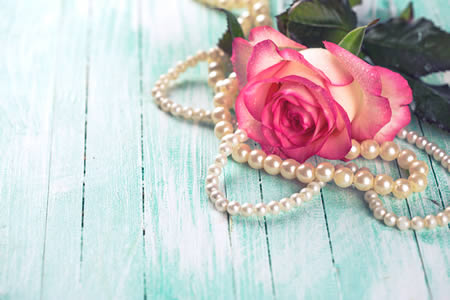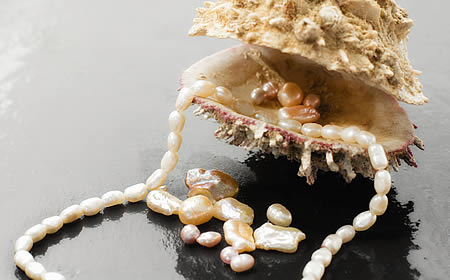Reference: The GemGuide by Gemworld International, Inc.

Pearls are organic gem and believed to be one of the oldest gem materials. Their use in personal adornment dates back more than 6,000 years.
Pearls are produced by living organisms called mollusks. Mollusks are soft bodied invertebrates,many varieties of which are protected by hard shell exteriors such as clams, oysters and mussels. One thing that all pearl producing mollusks share in common is the ability to build a mother-of-pearl lining on the inside of their shell.
Pearls can form when an irritant (a parasite or a foreign object) enters the mollusk and cannot be expelled. To reduce the irritation caused by the object, the mollusk coats the irritant in a secretion of conchiolin followed by layers of nacre. As the mollusk builds layer upon layer of nacre over the irritant, the irritating effect of the foreign object is diminished. Eventually the object is completely coated in a layer of pearly nacre. The "pearl" may be affixed to the inner shell or loose within the tissue of the mollusk.
A cultured pearl is formed when a human technician initiates the process by inserting a nucleus (often a round bead made from freshwater mussel shell) and a small piece of mantle tissue into an incision made in the oyster's reporduction organ or mussel's soft tissue. The "seeded" mollusk responds to this irritant in much the same way it would a naturally occuring irritant by producing and coating the bead with conchiolin and nacre.
There are two types of Pearls, Saltwater and Freshwater.
Saltwater Cultured Pearls are produced by three different types of oysters. The Pinctada fucata is commonly called the Akoya Oyster. These oysters inhabit the coastal waters of Japan, China, Vietnam and Australia. The typical pearl size produced is 4 to 8 mm. The body color of the pearl is usually white to light cream. Akoya pearls are generally round to off-round.

The Pinctada margaritifera is known as the black-lipped oyster. This oyster variety is found in French Polynesia and elsewhere in the Pacific. This is the oyster that produces the famed Tahitian cultured black pearls. The typical size range is 9mm to 15mm. The body color ranges from black to white with black, brown, grey and green, copper, and blue. Peacock Tahitian cultured pearls are most desired. Typical shapes are round, off-round, and drop.
Pinctada maxima, commonly known as the gold-lipped and silver-lipped oysters, are also found throughout the Pacific, but Australia, Indonesia and the Philippines are the primary producers. This species is the largest of the pearl bearing oysters, attaining a diameter of up to 30 centimeters. They produce the white, silver and golden south sea cultured pearls. The typical pearl size is 10mm to 16mm.
The bulk source of cultured freshwater pearls in mainland China, but Japan and the USA also produce a range of freshwater cultured pearls products.The majority of Chinese varieties are tissue nucleated. Freshwater Cultured Pearls are produced in a wide-ranging palette of natural colors. These include copper, pink, mauve, white, golden, orange, lavender, light green and silver. Dyed colors are also common especially in the commercial category. Irradiated pearls are also encountered/. Currently, many shapes are produced including, bar, button, coin, corn, cross, drop, potato and rice. However, off-round and round and can sometimes be confused with the saltwater cultured pearls.
There are three primary pearl producing freshwater varieties. This has dramatically changed in the recent years as many are hybrid varieties now. Cristaria plicata is found in the rivers and lakes of China and Japan. This variety of mussel produced the large volume of irregular shaped Chinese freshwater pearls that entered the jewelry industry during the 1970's and 1980's. Pearls ranged in color from white to cream and other colors, Surfaces were usually textured the term rice krispie was used to describe this product.
Hyriopsis cumingi, also known as the triangle mussel , is a large freshwater mussel found in lakes, rivers, and ponds in China and elsewhere. This is the mussel that produced many of the large Chinese freshwater pearls that entered the market during the late 1990's. The size range of pearls produced by this mussel is vast. Shapes range from round to the unusual.Off-round and potato are the most common.
The third freshwater producing variety is actually a group of related American freshwater mussels. These mussels produce a variety of freshwater pearl products. American mussels also produce a significant amount of the shell used as bead nuclei in saltwater pearl cultivation. This again changed in the recent decades. The nucleus comes from China for almost all pearl culturing processes in the world.
There are seven factors that contribute to the value of the akoya pearl. Those factors are size, shape, color, luster, blemishes, nacre quality, and matching. There is no specific standard grading system for evaluating freshwater cultured pearls as the criteria are very different than for all other pearl varieties. The recent round Chinese Cultured Freshwater products rival the quality of Seawater cultured pearl varieties and the grading criteria can be similar.

Price is based on two factors - shape and quality. Shape is acceptable in any form and the pearls are classified by the shape. The free forms are the least expensive and the near round and round are the most expensive. They are almost always a great deal less expensive than Saltwater cultured pearls. Well-formed baroque pearls are quite expensive and can be as high as rounds in large sizes.
Most cultured pearl varieties are enhanced. This is part of the processing (cleaning, polishing, etc.) that occurs after the pearls are harvested from the mollusk. Pearls can be dyed to apply an overtone or enhance the body color. Sometimes the dye can be detected by a mottled appearance on the surface of the pearl. Irradiating pearls is done to permanently alter the body color.
Pearls are traditional and always fashionable. They are made in all lengths and worn for all occasions. Brides often wear them on their wedding day. Pearls require extra care and should be wiped with a clean, soft cloth after each wear. If they need to be cleaned, they should be cleaned in warm, soapy water and dried thoroughly. They need to be restrung occasionally as the silk thread they are strung on can stretch and or break over a period of time. Good quality pearls are always knotted between each pearl.


